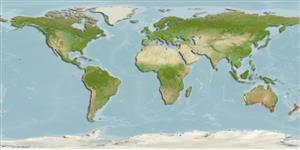Teleostei (teleosts) >
Mugiliformes (Mullets) >
Mugilidae (Mullets)
Eponymy: Fred C Aldrich was Chief Inspector of Fisheries and Game, Perth, Western Australia. We have failed to locate further information about him. Johann Reinhold Forster (1729–1798) was a German clergyman in Danzig (now Gdansk, Poland). [...] (Ref. 128868), visit book page.
More on author: Valenciennes.
Environment: milieu / climate zone / depth range / distribution range
Ecology
Marine; freshwater; brackish; demersal; catadromous (Ref. 46888); depth range 0 - 50 m (Ref. 9003), usually 0 - 10 m (Ref. 9812). Temperate; ? - 28°C (Ref. 28706); 25°S - 47°S, 112°E - 173°W
Southwest Pacific: throughout New Zealand and the Chatham Islands; also from eastern, western Australia, southern Australia and Tasmania.
Size / Weight / Age
Maturity: Lm ? range ? - ? cm
Max length : 50.0 cm SL male/unsexed; (Ref. 44894); common length : 25.0 cm TL male/unsexed; (Ref. 9258); max. published weight: 950.00 g (Ref. 26498); max. reported age: 7 years (Ref. 9003)
Dorsal spines (total): 5; Dorsal soft rays (total): 9; Anal spines: 3; Anal soft rays: 12. More pointed head and mouth than Mugil cephalus, and their eyes lack adipose (fatty) eyelids. Body scales are small (54-64 between gill opening and tail base) and thin, and are easily dislodged. 2 widely separated dorsal fins, the first with 4 spines and the second with 1 spine and 9 rays. These fish are olive or bluish brown above and silvery on the sides, and their eyes are bright yellow or golden. The fins have brown margins.
Found over sandy and muddy bottoms of coastal waters, bays, estuaries, and may ascend rivers into freshwaters (Ref. 9812, 44894). Adults inhabit brackish coastal lakes (Ref. 44894). Found in schools (Ref. 9812). Shoal-forming (Ref. 44894). They are omnivores, feeding mostly on benthic detritus, algae and small invertebrates. Oviparous, eggs are pelagic and non-adhesive (Ref. 205). Spawn in coastal waters in summer and autumn, probably in estuaries (Ref. 9812, 27012, 28470, 28707, 28708). Marketed fresh (whole gutted or fillets), smoked, salted or as roe (Ref. 3383).
Yellow eye mullet form large aggregations prior to spawning (Ref. 6390).
Kailola, P.J., M.J. Williams, P.C. Stewart, R.E. Reichelt, A. McNee and C. Grieve, 1993. Australian fisheries resources. Bureau of Resource Sciences, Canberra, Australia. 422 p. (Ref. 6390)
IUCN Red List Status (Ref. 130435: Version 2024-2)
Human uses
Fisheries: commercial; gamefish: yes
Tools
Special reports
Download XML
Internet sources
Estimates based on models
Preferred temperature (Ref.
123201): 13.5 - 20.2, mean 17.1 °C (based on 354 cells).
Phylogenetic diversity index (Ref.
82804): PD
50 = 1.0000 [Uniqueness, from 0.5 = low to 2.0 = high].
Bayesian length-weight: a=0.01175 (0.00555 - 0.02485), b=2.96 (2.79 - 3.13), in cm total length, based on LWR estimates for this (Sub)family-body shape (Ref.
93245).
Trophic level (Ref.
69278): 2.5 ±0.26 se; based on food items.
Generation time: 2.2 ( na - na) years. Estimated as median ln(3)/K based on 1
growth studies.
Resilience (Ref.
120179): Medium, minimum population doubling time 1.4 - 4.4 years (tm=2-3; tmax=7; Fec=125,000).
Fishing Vulnerability (Ref.
59153): Low to moderate vulnerability (29 of 100).
Nutrients (Ref.
124155): Calcium = 45.6 [15.7, 139.4] mg/100g; Iron = 0.36 [0.14, 1.08] mg/100g; Protein = 18.4 [16.4, 20.5] %; Omega3 = 0.804 [0.340, 1.805] g/100g; Selenium = 34.3 [12.1, 99.0] μg/100g; VitaminA = 8.44 [1.77, 41.50] μg/100g; Zinc = 0.918 [0.449, 1.692] mg/100g (wet weight); based on
nutrient studies.
